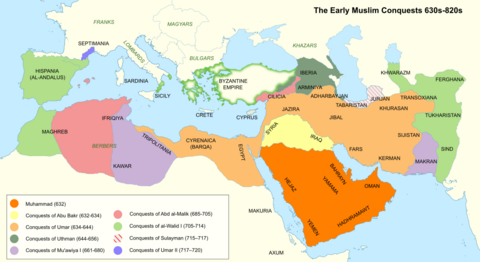- This page was last modified on 1 January 2026, at 00:05. Suggest an edit.
al-Walid I facts for kids
|
|||||
|---|---|---|---|---|---|
|
|||||
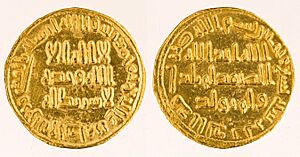
Gold dinar of al-Walid, minted in Damascus, 707/08 CE
|
|||||
| 6th Caliph of the Umayyad Caliphate | |||||
| Reign | 9 October 705 – 23 February 715 | ||||
| Predecessor | Abd al-Malik | ||||
| Successor | Sulayman | ||||
| Born | c. 674 Medina, Hejaz, Umayyad Caliphate |
||||
| Died | (aged c. 41) Dayr Murran, Damascus, Syria |
||||
| Burial | Bab al-Saghir or Bab al-Faradis, Damascus | ||||
| Spouse |
|
||||
| Issue | |||||
|
|||||
| House | Marwanid | ||||
| Dynasty | Umayyad | ||||
| Father | ʿAbd al-Malīk | ||||
| Mother | Wallāda bint al-ʿAbbās ibn al-Jazʾ | ||||
| Religion | Islam | ||||
Al-Walid ibn Abd al-Malik ibn Marwan (born around 674 – died February 23, 715), often called al-Walid I, was the sixth Caliph of the Umayyad Caliphate. He ruled from October 705 until his death in 715. He was the oldest son of the previous Caliph, Abd al-Malik.
During his rule, the Umayyad Caliphate grew to its largest size ever. Al-Walid I continued his father's work of making the government stronger and expanding the empire. He built many important public works, like the famous Umayyad Mosque in Damascus. He also started programs to help the poor and disabled. Many people in Syria thought highly of him. His time as caliph was a period of peace and wealth for the empire.
Contents
Early Life and Rise to Power
Al-Walid was born in Medina around 674. This was during the rule of Mu'awiya I, who founded the Umayyad Caliphate. His father, Abd al-Malik ibn Marwan, was part of the Umayyad family.
Family's Journey to Power
The Umayyad family faced challenges during a civil war. Al-Walid's family had to move from Medina to Syria. In Syria, his grandfather, Marwan I, became caliph. Marwan helped bring the Umayyad dynasty back to power in Syria and Egypt. After Marwan, al-Walid's father, Abd al-Malik, became caliph. Abd al-Malik conquered more lands, including Iraq and Iran. He made the government stronger with the help of his powerful governor, al-Hajjaj ibn Yusuf.
Leading Military Campaigns
Al-Walid gained experience by leading military campaigns against the Byzantine Empire. These wars had been going on for a long time. From 696 to 699, al-Walid led yearly attacks. He also led the annual Hajj pilgrimage to Mecca in 698.
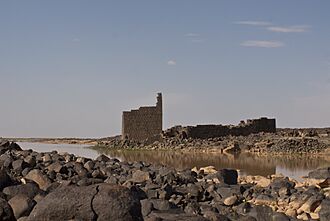
The ruins of Qasr Burqu', a fortified outpost in the Syrian Desert built or expanded by al-Walid while he was still a prince in 700/01 CE
Around 700 or 701, al-Walid helped build or expand Qasr Burqu'. This was a fortified outpost in the Syrian Desert. It was on a route that connected Palmyra to Mecca and Medina. This showed his growing importance before he became caliph.
Al-Walid's Time as Caliph
Al-Walid became caliph on October 9, 705, after his father, Abd al-Malik, passed away. He continued his father's goals of making the government more centralized and expanding the empire. Al-Walid relied heavily on al-Hajjaj ibn Yusuf, who was a very powerful governor in the eastern part of the caliphate. Al-Hajjaj had a lot of influence on al-Walid's decisions.
Expanding the Caliphate's Borders
Under al-Walid, the Muslim armies began a new period of great conquests. The Umayyad Caliphate reached its largest size during his rule.
Conquests in the East
In the east, al-Hajjaj oversaw the expansion. His general, Qutayba ibn Muslim, led several campaigns into Transoxiana (Central Asia) between 705 and 715. He conquered important cities like Bukhara and Samarkand. Another general, Muhammad ibn al-Qasim, conquered Sind in northwestern South Asia.
Conquests in the West
In the west, al-Walid's governor in North Africa, Musa ibn Nusayr, conquered more lands in the Maghreb (western North Africa). In 711, Musa's freedman, Tariq ibn Ziyad, led an army into Hispania (modern-day Spain and Portugal). By 716, most of Hispania was conquered. The huge amounts of treasure gained from these conquests helped fund al-Walid's projects.
Battles with the Byzantines
Al-Walid appointed his half-brother Maslama ibn Abd al-Malik to lead the war against the Byzantine Empire. While the Umayyads didn't gain much new land, they strengthened their control over existing areas. Al-Walid's eldest son, al-Abbas ibn al-Walid, also fought bravely in these campaigns.
Managing the Provinces
Al-Walid made sure his empire was well-governed. He placed his sons in charge of military districts in Syria. His brother, Sulayman ibn Abd al-Malik, was governor of Palestine.
Changes in Egypt
During al-Walid's reign, Arabic replaced Greek and Coptic as the official language of government departments in Egypt. This was part of a larger effort to make Arabic the main language of the state. In 709, al-Walid appointed Qurra ibn Sharik al-Absi as the new governor of Egypt. Qurra improved tax collection and rebuilt the Mosque of Amr ibn al-As in Fustat.
Governors in the Holy Cities
Al-Walid also made changes in the Hejaz, where the holy cities of Mecca and Medina are located. He appointed his cousin, Umar ibn Abd al-Aziz, as governor. Umar was well-liked by religious scholars. However, al-Walid later replaced him to prevent the region from becoming a center of opposition.
Public Works and Social Help
Al-Walid started many public works and social welfare programs. These were paid for by the wealth from the conquests and taxes.
Building Roads and Cities
- He and his family built rest stops and dug wells along roads in Syria.
- They installed street lighting in cities.
- They invested in irrigation projects to help farming.
- Al-Walid or his son founded the city of Anjar in 714. It had a mosque, palace, and other buildings.
- In the Hejaz, he had water wells dug and improved mountain passes for pilgrims going to Mecca.
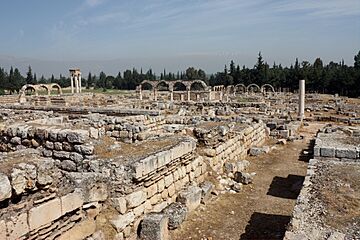
Ruins of the Umayyad city of Anjar, founded by al-Walid I in modern-day Lebanon
Helping People in Need
Al-Walid's government provided financial help for the poor. They also provided servants to assist people with disabilities. These programs were mainly for Arab Muslims in Syria.
Building Great Mosques
Al-Walid was famous for building and improving grand mosques. This showed his power and religious devotion.
- The Umayyad Mosque in Damascus: This was his greatest building project. In 705, he converted a Christian cathedral into a large mosque. It was finished in 711. This mosque became a symbol of Islam's strength. It still looks much like it did when al-Walid built it.
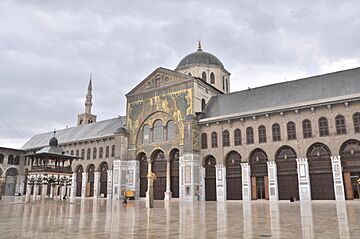
The Umayyad Mosque of Damascus, which has maintained much of its original form since its founding by al-Walid
- Al-Aqsa Mosque in Jerusalem: He continued his father's work on the Temple Mount in Jerusalem. He likely finished or expanded the al-Aqsa Mosque. Egyptian workers and craftsmen were sent to help build the "Mosque of Jerusalem."
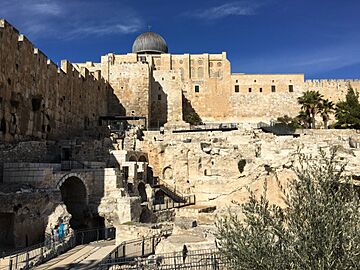
Excavated ruins of the Umayyad palatial and administrative structures beneath the al-Aqsa Mosque and the southern wall of the Temple Mount. These unfinished buildings and the al-Aqsa Mosque are generally attributed to al-Walid, though the mosque has been substantially altered since al-Walid's reign.
- The Prophet's Mosque in Medina: In 706 or 707, al-Walid ordered the expansion of the Prophet's Mosque in Medina. This included adding the graves of Muhammad and the first two caliphs. He spent a lot of money on this project and brought in skilled craftsmen. Building a large mosque in Medina was a way to honor the city's importance in Islam.
Death and What Came Next
Al-Walid died from an illness on February 23, 715, near Damascus. He was buried in Damascus.
He had tried to make his son, Abd al-Aziz, his successor, but this didn't happen. His brother, Sulayman ibn Abd al-Malik, became the next caliph. Sulayman removed most of al-Walid's governors. While Sulayman continued some of al-Walid's military policies, the empire's expansion slowed down.
Al-Walid's Impact and Legacy
Historians often see al-Walid's rule as the peak of Umayyad power. He built on his father's efforts to create a strong, unified Islamic state. His reign was a time of peace and wealth.
Achievements and Reputation
- The conquests in Hispania, Sind, and Transoxiana brought great wealth to the caliphate.
- His support for building the grand mosques in Damascus and Medina was very important.
- His charitable work for the poor and disabled was also notable.
- People in Syria at the time thought he was one of their best caliphs.
Al-Walid was known for living in grand palaces. He spent a lot of money on his relatives, which became a financial challenge for later caliphs. The cost of equipping and paying the armies for conquests was also very high.
Family Life
Al-Walid had many marriages, at least nine. These marriages helped him form political alliances with important families. He had 22 children, many of whom were born to slave concubines. His son Yazid III was born to Shah-i-Afrid, who was the daughter of a Persian prince.
Later, in 744, some of al-Walid's sons were involved in a plot to overthrow their cousin, Caliph al-Walid II. This led to a civil war. Some of al-Walid's descendants survived and became important in the Umayyad emirate in al-Andalus (Spain) after the Umayyad dynasty fell in 750.
See Also
|

